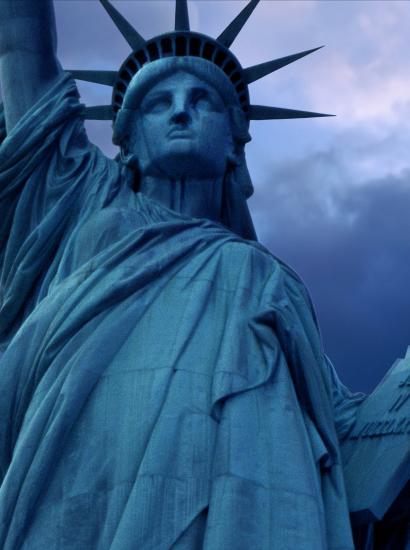- Law & Policy
- Immigration
The United States issued more than 60 million “entry” visas in 2013 to foreigners who intended to visit the country but not immigrate permanently. Most went to individuals who came temporarily for pleasure (48 million) or business (6 million). Another three million went to individuals and their families to work in the United States, and 1.7 million went to foreign students. (Note: The number of “entries” is greater than the number of individuals with visas, since it is possible to leave and reenter the country on the same visa.)
Foreign nationals who want to work in the United States must navigate among eleven classes of nonimmigrant visas, totaling more than seventy specific types. Nonimmigrant typically means that a visa is temporary and that the individual does not intend to settle permanently. This wide array of visa types would seem to cover almost every imaginable individual or work possibility; it also means, however, that foreigners who want to work in the United States have a veritable alphabet soup of visa application decisions to make.
Temporary work visas are frequently split into high-skilled and low-skilled workers. On the high-skilled side, the largest temporary work visa program is the L-1 intracompany transfer. Although there is no quota, there are between 700,000 and 800,000 L-1 visa entries – both new and renewals, workers and dependents – each year. One estimate puts the stock at around 350,000 L-1 visa holders in the country at any one time. The program allows international companies to send workers and their families overseas and to bring foreign workers to the United States based on reciprocity schedules with their respective countries. This bypasses the emotional debate about foreigners stealing jobs since US and foreign employees of the same company effectively trade places. L-1 visa holders can stay up to seven years depending on their country of origin. Considering the program’s relative size and function, L-1 migrants are often left out of the national immigration debate.
The H-1B high-skilled visa is one program that features prominently in the debate over immigration reform. Although about 475,000 entries on H-1B visas each year, a quota on new visas begins at 65,000 and adds an additional 20,000 for foreign graduates of US universities. The annual application period for those 85,000 visas opens on April 1 of each year. This year, the United States Citizenship and Immigration Service (USCIS), which administers the applications, stopped accepting applications on April 7 because it had received so many. In total, USCIS announced 172,500 applications had been submitted before the window closed. Because the quota for H-1B visas is fixed, USCIS holds a lottery among the applications that were submitted while the window was open. In other words, the US high-tech visa program is a lottery system within a quota system. This year marks the twelfth consecutive year of hitting the cap on visas; the only reason it wasn’t reached in the three earlier years was because the cap had been lifted to 195,000 from 2001 to 2003 following the dotcom bubble. Technology companies, especially in Silicon Valley, have called for expanded limits on the number of H-1B visas.
The most prominent low-skilled work visas are the H-2A agricultural visa and the H-2B nonagricultural visa. H-2A visas are technically unlimited but come with numerous employer requirements set by the Department of Labor (DOL) that drive up the cost of legally hiring foreign agricultural workers. H-2A visas are allowed to be issued for seasonal labor only, usually ten months; employers can request that visas be reissued the following year for three years. Once a foreign worker has spent three years in the United States on H-2A status, he or she must leave the country and wait three months until reapplying for another H-2A visa. Under the 50 percent rule, employers are legally obligated to hire any US worker who applies for the same position during the first half of the H-2A’s work contract. Some 200,000 entries to the country on H-2A visas were granted last year.
H-2B nonagricultural visas are for non-college-graduate foreigners who want to work temporarily in the United States. Workers are only eligible to obtain H-2B visas if not enough US workers are “able, willing, qualified, and available to do the temporary work.” Legally, the foreigners’ presence is not allowed to affect adversely the wages of similarly employed US workers. Employers must obtain DOL certifications in the same way as those who employ H-2A workers, although they are not obligated to provide housing and food costs. DOL certifications list landscape labor, amusement park worker, forest worker, housekeeper, and industrial commercial groundskeeper as the top occupations of H-2B certified workers. There is a cap of 66,000 H-2B new visas each year; they are then split into two waves of 33,000 six months apart. Visa holders may obtain extensions for up to three years. Just fewer than 105,000 total entries on H-2B visas were issued last year.
There are many other kinds of temporary worker visas: extraordinary ability and achievement (O1), trainees (H3), famous athletes and entertainers (P1), and so on. Although some of these programs may not be well known, the number of nonimmigrant visas issued is large. The North American Free Trade Agreement category of professional workers (TN) has included grants of anywhere between 600,000 and 900,000 entries in recent years. There are visas for “treaty traders and investors” and their dependents (E1 to E3) that make up another 375,000 to 450,000 temporary admissions a year. On the student side, half a million exchange students (J1) joined 1.7 million US college students during the past year.
The US population is around 314 million people. The more than sixty million visas granted to visitors bring in large economic benefits through spending on tourism, investment in businesses, and advances at research departments in universities and companies across the US. Those benefits would be much higher if constraints on nonimmigrants were reduced.
(Note: Language in “Basic Facts” and “Background on the Facts” has been updated to clarify the difference between nonimmigrant admissions and new visas granted. The same individual may use the same visa to reenter the country many times.)















